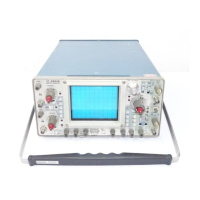Operating Instructions—465B
Service
24)
COUPLING Switch—Determines
method
used to
couple
signals
to
the trigger generator
circuit
AC—Signals are
capacitively coupled to the
input
of the
trigger circuit. Dc is rejected,
and signals
below about 30 hertz are
attenuated. Triggering is
allowed
only on the ac portion of the
vertical
signal.
LF REJ—
Signals are capacitively coupled to the
input of the trigger
circuit Dc is rejected,
and
signals below
about
50
kilohertz are attenuated
It
is useful
for
providing
a
stable display of the high-
frequency components of a complex
waveform.
HF REJ—
Signals are capacitively coupled to
the
input
of the trigger circuit. Dc is blocked,
and
signals below about 30
hertz and above 50
kilohertz are
attenuated. It is useful for providing
a stable
display of the low-frequency com-
ponents of a
complex waveform
DC—All frequency
components of a
trigger
signal are coupled to the
input of the
trigger
circuit. It is useful for
providingastabledisplay of
low-frequency or low-repetition rate
signals
25)
SLOPE Switch—Selects
the slope of the signal that
triggers
the
sweep.
+: Sweep can be
triggered from
the
positive-
going
portion
of a
trigger signal
Sweep can be triggered
from
the
negative-
going portion of a trigger signal.
(2?)
LEVEL Control—
Selects the amplitude point
on
the
trigger signal at which the
sweep
is
triggered It is
usually adjusted for the
desired display after trigger
SOURCE, COUPLING, and
SLOPE have been
selected.
NORM—
Trigger source is a sample
of the
signal
displayed
on the crt.
CH
1—
A
sample of the
signal applied to the
Channel 1
input
is
used as a
trigger signal.
Channel 2
signal is
unstable
if
it
is
not time-
related.
CH
2—
A
sample
of
the signal applied to
the
Channel
2
input is used
as a trigger
signal
Channel 1 crt display is
unstable if it is not
time-
related
LINE
(A Trigger Circuit
Only)—A sample
of the
power-line sinusoidal
waveform is used as
a
trigger signal. It is useful
when the input
signal is
time-related
(multiple or
submultiple) to the line
frequency or
when it is
desirable to provide a
stable display of a
line-frequency
component in a
complex
waveform
EXT—Signals connected to the
External Trigger
input
connectors are used for triggering.
External
signals must be
time-related to the
displayed
signal for a
stable display, it is useful when the
internal signal is
either too small or contains
undesired
signals that could cause
unstable
triggering. It is also useful
when operating in the
CHOP mode EXT
and
EXT/10
trigger signals
may be
viewed on the crt by selecting
A TRIG
VIEW on the VERT MODE switch
EXT/10 (A
Trigger Circuit Only)—External
trigger signal is attenuated by a
factor of 10
STARTS
AFTER
DELAY
(B
Trigger Circuit
Only)—B
Sweep starts
immediately
after
the
delay time selected by
the
DELAY
TIME
POSITION
control and
is
independent of
the
B
Trigger signal.
When making
differential time
measurements,
you must use this
mode to obtain
valid
measurements. On
instruments equipped
with a DM44
you must use this
mode to obtain
valid
measurements when
using the TIME or
1/TIME
functions
(27)
SOURCE Switch—
Determines the source of the
trigger
signal coupled to the input of the trigger
circuit.
External Trigger Input
Bnc Connectors—
Connect
external trigger input
signals
for
A
TRIGGER and B
(DLY’D)
TRIGGER circuits, when
either EXT or
EXT/10
(A Trigger only)
SOURCE is
selected
26

